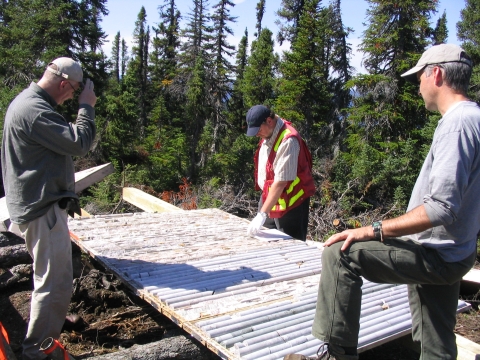Vancouver – An aggressive drill campaign by Aurora Energy Resources (AXU-T, AUEGF-O) on its Central Mineral Belt (CMB) projects in coastal Labrador has led to the discovery of a new zone of near surface uranium mineralization at Jacques Lake.
Jacques Lake is located about 30 km northeast from the company’s Michelin deposit along a structural corridor and in a similar setting. Three recent core holes all intersected wide intervals of uranium mineralization including:
- Hole JL-06-18 intersected 21 metres (from 96.5 metres downhole depth) grading 0.21% U3O8, including a 12-metre interval of 0.3% U3O8; a second parallel zone also returned 0.11% U3O8 across 5 metres (at 122 metres depth);
- Hole JL-06-19 cut 46 metres (from 118 metres depth) averaging 0.10% U3O8 with a 25 metre section of 0.12% U3O8; and
- Hole JL-06-20 returned 57.7 metres (from 138 metres depth) of 0.11% U3O8 that included intervals of 0.13% U3O8 over 21.1 metres and 0.20% U3O8 across 7 metres.
All three holes were collared in the same location to test the mineralized zone at different depths.
“We now know that this deposit has near-surface grades and widths comparable to the best parts of Michelin, and we are increasingly confident of its potential to grow into a Michelin-sized resource,” stated Rick Valenta, Aurora’s chief geoscientist.
Aurora is encouraged by the results as they confirm bedrock uranium is much more widespread than indicated by the geophysical data. The holes were drilled 250 metres southwest of the main Jacques Lake radiometric anomaly in an area with no uranium signature in the radiometric data.
The company’s Michelin uranium deposit is the primary target of this year’s 40,000-metre drill program, designed to test its depth potential and upgrade the project’s resource.
In early-2006, a measured and indicated resource of almost 9 million tonnes grading 0.113% U3O8 (containing 22.2 million pounds of U3O8) was reviewed at Michelin, occurring from surface to about 250 metres depth. An additional 4.1 million tonnes of inferred resource grading 0.148% U3O8 was estimated in deeper portions of the deposit (to about 700 metres), based on seven widely spaced drill holes.
Both stratabound and shear-hosted uranium mineralization occurs at Michelin within a volcanic suite of porphyritic tuffs and fragmental rhyolites, and is associated with structural zones paralleling the east-northeast trending and moderately south dipping stratigraphy. The deposit consists of several sub-parallel mineralized zones occurring from surface to at least 700 metres depth. Geologic studies of the camp are also examining the iron oxide-copper-gold (IOCG) analogy of the project model.
Initially formed in early-2003 to hold Fronteer Development Group‘s (FRG-T, FRG-X) and partner Altius Minerals‘ (ALS-V) CMB projects, Aurora became a public company earlier this year through an initial public offering. Fronteer and Altius retain about 49.3% and 19.9% interests in Aurora respectively following its spin-out, with Altius also holding a 2% royalty on the projects.
Shares of Aurora Energy have rallied to new highs on the latest Jacques Lake results, touching the $11-level. The company posts a $660-million market capitalization given its 61-million shares outstanding.


Be the first to comment on "Aurora Energy hits new uranium zone at Jacques Lake"